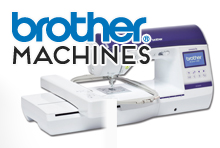
How to Free Motion
Free motion sewing allows you to stitch in all directions for machine embroidery and quilting.
-
Lower the feed dogs by using the slider either at the back of the machine behind the needle, or at the front, visible when you remove the flat bed attachment. Most models have little embossed diagrams next to the slider, with teeth below a line (lowered feed dogs) or teeth above the line (raised for regular sewing).
-
Attach a darning foot – to do this you will need to unscrew the shank holding the clip-on feet and remove it. The darning foot has a U-shaped clamp which wraps around the shank stem and is held in place by the screw. Note, when lowered it does not sit firmly on the throat plate as a regular presser foot, rather it hovers a little way above.
-
Set the stitch length to 0 or as close to 0 as possible. Thread the machine with normal thread and back your fabric with interfacing, stabiliser or wadding. The latter will give the fabric a nice textural surface as the stitching holds layers together firmly and the unstitched areas will appear slightly raised. Interfacing or stabiliser provides added support to the fabric, which will prevent it puckering as you stitch.
-
Place the fabric under the needle, lower the presser foot (even though it doesn’t grip the fabric, it needs to be lowered to engage the tension discs). With hands flat on the fabric either side of the needle, put your foot on the pedal and start moving the material in any direction. It is best to put your foot down firmly so the machine is going fast and you then move the fabric slowly. The slower you move, the smaller the stitches, the quicker you move, the larger the stitches.
 Retro Mixtape Cushion
Retro Mixtape Cushion
 Flossie Flamingo Softie Toy Sewing Pattern
Flossie Flamingo Softie Toy Sewing Pattern
 Dave Dachshund
Dave Dachshund
 Sewing Bee Shift Dress
Sewing Bee Shift Dress
 Nigel the Dragon Plushie Toy Sewing Pattern
Nigel the Dragon Plushie Toy Sewing Pattern
 Floaty Floral Three Quarter Sleeved Dress
Floaty Floral Three Quarter Sleeved Dress
 Sewing Bee Sleeveless Shell Top
Sewing Bee Sleeveless Shell Top
 Cat Softie Toy With Sleeping Bag Sewing Pattern
Cat Softie Toy With Sleeping Bag Sewing Pattern
 Arabella Blouse
Arabella Blouse
 Vintage-Style Memory Teddy Bear Sewing Pattern
Vintage-Style Memory Teddy Bear Sewing Pattern
 Easy Roger Reindeer Christmas Sewing Pattern
Easy Roger Reindeer Christmas Sewing Pattern
 Origami Fabric Boxes
Origami Fabric Boxes
 Child’s Storage Chair Tidy Sewing Pattern
Child’s Storage Chair Tidy Sewing Pattern
 Easy Kids’ Piggy Purse Sewing Pattern
Easy Kids’ Piggy Purse Sewing Pattern
 Embroidered Make-up Pouch Sewing Pattern
Embroidered Make-up Pouch Sewing Pattern
 Motivational Wall Hanging Sewing Pattern
Motivational Wall Hanging Sewing Pattern
 Simple Daisy Keyring Sewing Pattern
Simple Daisy Keyring Sewing Pattern
 Knitting Project Storage Bag Sewing Pattern
Knitting Project Storage Bag Sewing Pattern
 Violet the Victorious Doll: Superhero Sewing Pattern Part 2
Violet the Victorious Doll: Superhero Sewing Pattern Part 2
 Overnight Bag Template: The Crafts Channel
Overnight Bag Template: The Crafts Channel
 Simple Teepee Bag Template: The Crafts Channel
Simple Teepee Bag Template: The Crafts Channel
 Astrology Embroidery Hoops Sewing Pattern
Astrology Embroidery Hoops Sewing Pattern
 Handstitched toy labels
Handstitched toy labels
 Classic Polka Dot Dress Sewing Pattern
Classic Polka Dot Dress Sewing Pattern













